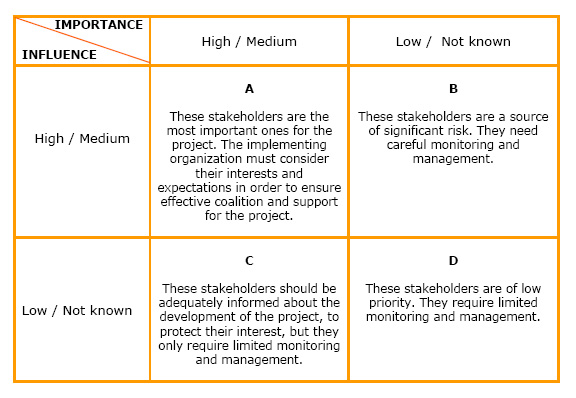Difference between revisions of "Stakeholder Analysis"
From Learning and training wiki
| Line 35: | Line 35: | ||
#*Manage and coordinate arrangements appropriately to promote stakeholder ownership, participation, and avoid conflicts of interest. | #*Manage and coordinate arrangements appropriately to promote stakeholder ownership, participation, and avoid conflicts of interest. | ||
#*Design partnerships in a flexible way, allowing growth. | #*Design partnerships in a flexible way, allowing growth. | ||
| − | #*Decide, in case the stakeholder is a group rather than an individual, whether all the group participate or only representatives | + | #*Decide, in case the stakeholder is a group rather than an individual, whether all the group participate or only its representatives. <ref> [http://www.euforic.org www.euforic.org] (14 August 2008), [http://www.landcarersearch.co.nz www.landcarersearch.co.nz] (14 August 2008), [http://www.who.int www.who.int] (14 August 2008), Project Cycle Management Guidelines, European Commission, 2004</ref> |
=='''Stakeholder Matrix'''== | =='''Stakeholder Matrix'''== | ||
Revision as of 11:24, 4 September 2008
| The identification of a project's key stakeholders, an assessment of their interests and the ways in which those interests affect project viability. A basic premise behind stakeholder analysis is that different groups have different concerns, capacities and interests, and that these need to be explicitly understood and recognized in the process of problem identification, objective setting and strategy selection. The key questions asked by stakeholder analysis are "Whose problems or opportunities are being analyzed" and "Who will benefit or loose-out, and how, from a proposed project intervention"? The ultimate aim being to help maximize the social, economic and institutional benefits of a project to target groups and ultimate beneficiaries, and to minimize its potential negative impacts, including stakeholder conflicts. A stakeholder analysis develops a strategic view of the social environment in which a project will be implemented, thus it is usually the first step in building the relationships needed for the success of a project. A stakeholder analysis can be undertaken throughout all the stages of a project cycle. It can be used to:
|
Step by Step
Stakeholder MatrixA stakeholder matrix allows for stakeholders to be plotted against different variables, taking into consideration their importance and their level of influence in the project. [3]
Job Aid |
References
- ↑ www.landcareresearch.co.nz (23 July 2008), www.panda.org (23 July 2008); Aid Delivery Methods - Project Cycle Management Guidelines, European Commission, 2004
- ↑ www.euforic.org (14 August 2008), www.landcarersearch.co.nz (14 August 2008), www.who.int (14 August 2008), Project Cycle Management Guidelines, European Commission, 2004
- ↑ www.dse.vic.gov.au (14 August 2008)www.who.int (14 August 2008)
